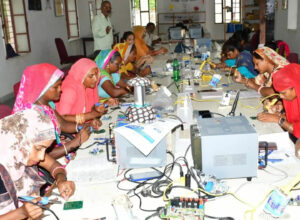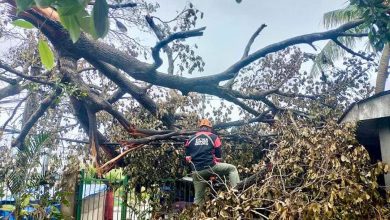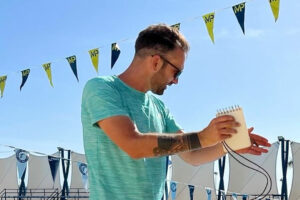Practical solutions to the education crisis: The Barefoot College

(Part 2)
There is much ado about the most recent results of the PISA achievement tests taken by teenage youth all over the world. The Program for International Student Assessment (PISA) assesses the knowledge and skills of 15-year-old students in mathematics, reading, and science. The tests explore how well students can solve complex problems, think critically, and communicate effectively. The Philippines participated in PISA for the first time in 2018. Unfortunately, the 2022 results showed the Filipino students remain among the world’s weakest in math, reading, and science. As in 2018, the latest PISA scores show that our students performed worse than the global average in all categories, with its placement in the country rankings (in Southeast Asia only better than Cambodia) moving up by just a few spots above countries that dropped ranks due to the COVID-19 pandemic’s impacts on student learning.
There was no significant difference in the Philippines’ performance in PISA 2022 compared to 2018, with the country’s average score in all categories changing by just single digits. The scores of the Philippine students are also still below the OECD average, although there were some slight improvements. The Philippines scored two points better in mathematics, going from 353 in 2018 to 355 in 2022. For science, the Philippine’ average score dropped by one point from 356 to 355. The biggest improvement was in reading in which the score rose from 340 to 347.
Based on the gap between the Philippines and other countries, Filipino students appear to trail behind their global counterparts, especially in the Indo-Pacific region, by an average of five to six years’ worth of schooling. Considering that today’s 15-year-olds will, in 10 years, be the ones entering the knowledge-intensive economy of a high-middle income country that the Philippines is expected to be by then, this acute learning poverty should be worrisome.
Fortunately, as we discussed in the first article of this series, there are serious efforts by the business sector, in partnership with the government and the academe, to address the roots of the education crisis, such as underinvestment in education, the poor quality of teachers, corruption in the Department of Education, etc. In the short run, however, there is no need to panic and start despairing over the present crop of workers in the labor force. There is much that can still be done to make productive use of even illiterate or half-illiterate young people among those who are already of working age.
There is hope for the households that fall below the poverty line (about 22% of the population) in which the majority of the youth do not even complete elementary education. As I pointed out in another series of articles in this publication, the global model of imparting useful skills to workers who are illiterate (using the PISA standards) is the NGO established by an Indian social activist and educator who founded the Barefoot College in India. Sanjit “Bunker” Roy was selected as one of Time Magazine’s 100 most influential personalities in 2010 for his work in educating illiterate and semi-illiterate rural Indians.
As one example of the many projects undertaken through the Barefoot College, between 2005 and 2011, 140 women, most of them grandmothers, traveled to Tilonia, India from villages in Africa to receive training as solar engineers. The African women did not know how to read or write, and none of them spoke any Indian language, and so their six-month training course was taught through sign language and color codes. Still by the end of it, they returned to their villages qualified to install, maintain, and operate household solar-powered lighting systems. They learned to install integrated circuit boards for solar home lights and off-grid solar units generating up to 500 kilowatts a day. These 140 women have brought solar electrical power to almost 10,000 rural homes in 21 African countries.
To date, the Barefoot College has trained more than 3 million people for jobs in the modern world. Bunker Roy has proved that illiterate or semi-illiterate people can be trained to be teachers, midwives, water-drillers, phone operators, blacksmiths, carpenters, masons, weavers, architects, dentists, and even doctors. What is more, all the training happened in buildings that are so rudimentary that they have dirt floors and no chairs. Indigenous students feel comfortable in such modest environments. Most of their teachers are from similar backgrounds and are graduates of the same school.
In the Philippines, there are numerous examples of NGOs imparting useful skills among illiterate or semi-illiterate people. One example with which I am very familiar is the initiative that one of my colleagues at the University of Asia and the Pacific, Dr. Veronica Ramirez, is undertaking with the cooperation of her husband, children, and friends among the Aetas in Zambales.
Let me quote directly from a report of Dr. Ramirez entitled “Accelerating Indigenous Aeta Women’s health awareness, wellbeing and economic inclusion” -— “Most of the Aetas in Castillejos (Zambales) are unschooled, only few have formal education in the lower grade levels. They end up having a family at a young age and then struggle through life with no education nor skill to earn a living for their family. To address this condition, the KAP [the foundation established by the Ramirez family] conducted a variety of capability-building projects… We identified the skills needed by the Aetas and wanted to tap local residents to teach them. We chose those who are good in their craft, who understand Aeta culture, have the patience in teaching and demonstration, and can show respect to the Aeta learners.”
Among the practical skills chosen for the training programs were:
Sewing. Some Aeta women were interested in learning sewing. Some of the friends of Dr. Ramirez sent textiles and other materials that could be sewn into bags, pillowcases, shorts, and blouses. Others donated sewing machines. A local seamstress conducted three-day sewing workshops. Each trainee received a sewing kit which included fabric scissors. The trainees were told that after the training, they were welcome to use the sewing machines in the training center for their livelihood.
Cookery. There was also a need to teach mothers how to cook nutritious and affordable food for their children, especially the very young ones whose brains will be permanently damaged if they are undernourished or malnourished at an early age. The common products the Aetas harvest from their home gardens are papaya, sweet potatoes, bananas and their blossoms, langka (jackfruit), bamboo shoots, and a variety of root crops. Some of Dr. Ramirez’s friends who know how to cook these farm products helped in teaching the Aeta women how to prepare nutritious and affordable dishes. The Aeta women were also taught the practice of cleanliness and hygiene, and the habit of wearing face masks and aprons while cooking. Best of all, they brought home their cooked dishes to their respective families.
Hair and nail care. The owner and operator of a beauty parlor in the neighborhood volunteered to teach the Aeta ladies the art of cutting hair. They needed special training because it is not easy to cut the kinky hair of these indigenous women. After the training, each one received a set of hair and nail care instruments.
Healthcare emergencies. Dr. Ramirez and her staff identified the 10 health emergencies that could occur in the mountains where the Aetas live. These are snake bites, cuts and wounds, breathing difficulty, physical collapse, severe stomach pains, severe head injury, injuries from falls from high place, cramps, burns, and arm fractures. Fortunately, there was a midwife in the community whose knowledge and skills were not limited to childbirth. She conducted the Health Emergency sessions. Each trainee received a First Aid Kit. A generous donor provided each community with a motorbike with side car (kulong kulong) for use during an emergency.
All these training and capacity building programs among illiterate or half-illiterate people, whether indigenous or not, are being replicated in poor communities all over the Philippines. I personally know of NGOs and individual social workers imparting very useful skills to indigenous people such as the Dumagats in Southern Luzon, the Mangyans in the island of Mindoro, and the Palawan tribe in Southern Palawan.
(To be continued.)
Bernardo M. Villegas has a Ph.D. in Economics from Harvard, is professor emeritus at the University of Asia and the Pacific, and a visiting professor at the IESE Business School in Barcelona, Spain. He was a member of the 1986 Constitutional Commission.




